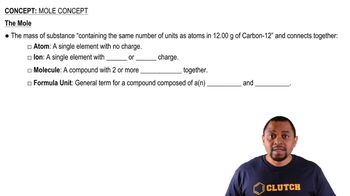Calculate the empirical formula for each stimulant based on its elemental mass percent composition.
a. nicotine (found in tobacco leaves): C 74.03%, H 8.70%, N 17.27%
b. caffeine (found in coffee beans): C 49.48%, H 5.19%, N 28.85%, O 16.48%
 Verified step by step guidance
Verified step by step guidance



Calculate the empirical formula for each stimulant based on its elemental mass percent composition.
a. nicotine (found in tobacco leaves): C 74.03%, H 8.70%, N 17.27%
b. caffeine (found in coffee beans): C 49.48%, H 5.19%, N 28.85%, O 16.48%
Calculate the empirical formula for each natural flavor based on its elemental mass percent composition. a. methyl butyrate (component of apple taste and smell): C 58.80%, H 9.87%, O 31.33%
Calculate the empirical formula for each natural flavor based on its elemental mass percent composition. b. vanillin (responsible for the taste and smell of vanilla): C 63.15%, H 5.30%, O 31.55%
The elemental mass percent composition of ascorbic acid (vitamin C) is 40.92% C, 4.58% H, and 54.50% O. Determine the empirical formula of ascorbic acid.
A 45.2-mg sample of phosphorus reacts with selenium to form 131.6 mg of the selenide. Determine the empirical formula of phosphorus selenide.